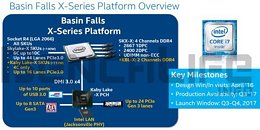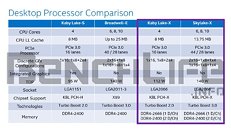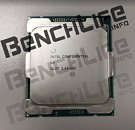- Joined
- Oct 9, 2007
- Messages
- 47,164 (7.57/day)
- Location
- Hyderabad, India
| System Name | RBMK-1000 |
|---|---|
| Processor | AMD Ryzen 7 5700G |
| Motherboard | ASUS ROG Strix B450-E Gaming |
| Cooling | DeepCool Gammax L240 V2 |
| Memory | 2x 8GB G.Skill Sniper X |
| Video Card(s) | Palit GeForce RTX 2080 SUPER GameRock |
| Storage | Western Digital Black NVMe 512GB |
| Display(s) | BenQ 1440p 60 Hz 27-inch |
| Case | Corsair Carbide 100R |
| Audio Device(s) | ASUS SupremeFX S1220A |
| Power Supply | Cooler Master MWE Gold 650W |
| Mouse | ASUS ROG Strix Impact |
| Keyboard | Gamdias Hermes E2 |
| Software | Windows 11 Pro |
Intel's next high-end desktop (HEDT) platform to succeed the current "Broadwell-E" LGA2011v3 will be the X-series "Basin Falls" platform. This consists of the "Skylake-X" and "Kaby Lake-X" processors, and a chipset derived from Intel's upcoming 200-series. Just as Intel changed sockets for its previous three HEDT platforms (LGA1366 for "Nehalem" and "Westmere/Gulftown," LGA2011 for "Sandy Bridge-E" and "Ivy Bridge-E," and LGA2011v3 for "Haswell-E" and "Broadwell-E,") the company will launch a new socket, the LGA2066.
As with its HEDT predecessors, "Skylake-X" and "Kaby Lake-X" will be multi-core processors devoid of integrated graphics, with double the memory bus width and up to triple the PCIe lane budgets as the desktop ("Skylake-D," eg: Core i7-6700) processors. In an interesting move, Intel will launch both "Skylake-X" and "Kaby Lake-X" in quick succession, with a catch - "Skylake-X" will come in 6-core, 8-core, and 10-core variants; while the "Kaby Lake-X" will initially only be offered in quad-core. The "Kaby Lake-X" chip will further only feature a dual-channel memory bus, and the LGA2066 motherboard will have half its DDR4 DIMM slots disabled, besides a few PCIe lanes.



The Core i7 "Skylake-X" processors, besides coming in 6-core, 8-core, and 10-core variants, could have sub-variants with fewer PCIe lanes. All chips will, however, feature quad-channel memory interfaces. Besides the DMI 3.0 (PCI-Express 3.0 x4 physical layer) chipset bus, "Skylake-X" chips will offer up to 44 PCI-Express gen 3.0 lanes. Interestingly, the chipset will have a much wider downstream PCIe lane budget than what we're used to seeing on Intel PCH chips for the past several generations - it offers a whopping 22 PCI-Express gen 3.0 downstream lanes. This could prove useful in driving bandwidth-hungry onboard devices such as Thunderbolt controllers, multiple PCI-Express SSDs, etc.
Intel plans to launch the Core i7 "Skylake-X" processors in as early as Q3-2017 (July-September 2017).
View at TechPowerUp Main Site
As with its HEDT predecessors, "Skylake-X" and "Kaby Lake-X" will be multi-core processors devoid of integrated graphics, with double the memory bus width and up to triple the PCIe lane budgets as the desktop ("Skylake-D," eg: Core i7-6700) processors. In an interesting move, Intel will launch both "Skylake-X" and "Kaby Lake-X" in quick succession, with a catch - "Skylake-X" will come in 6-core, 8-core, and 10-core variants; while the "Kaby Lake-X" will initially only be offered in quad-core. The "Kaby Lake-X" chip will further only feature a dual-channel memory bus, and the LGA2066 motherboard will have half its DDR4 DIMM slots disabled, besides a few PCIe lanes.



The Core i7 "Skylake-X" processors, besides coming in 6-core, 8-core, and 10-core variants, could have sub-variants with fewer PCIe lanes. All chips will, however, feature quad-channel memory interfaces. Besides the DMI 3.0 (PCI-Express 3.0 x4 physical layer) chipset bus, "Skylake-X" chips will offer up to 44 PCI-Express gen 3.0 lanes. Interestingly, the chipset will have a much wider downstream PCIe lane budget than what we're used to seeing on Intel PCH chips for the past several generations - it offers a whopping 22 PCI-Express gen 3.0 downstream lanes. This could prove useful in driving bandwidth-hungry onboard devices such as Thunderbolt controllers, multiple PCI-Express SSDs, etc.
Intel plans to launch the Core i7 "Skylake-X" processors in as early as Q3-2017 (July-September 2017).
View at TechPowerUp Main Site




